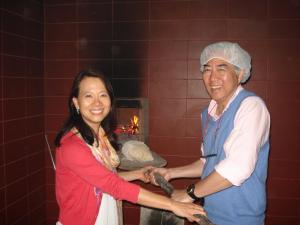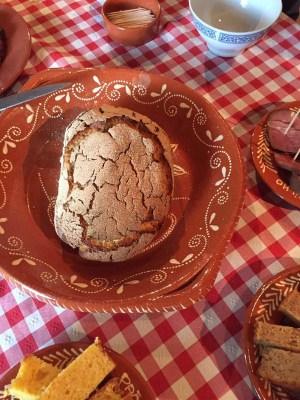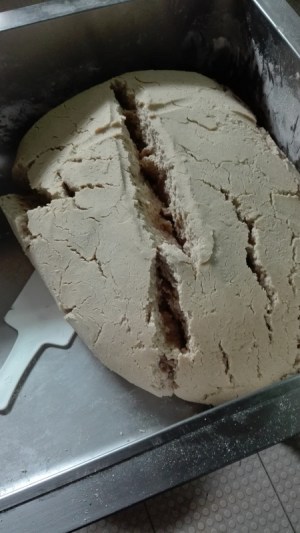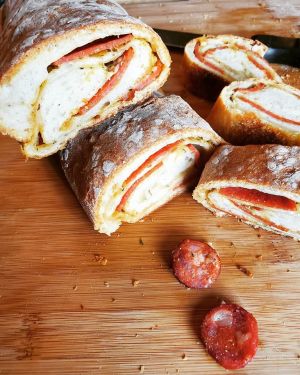Portuguese CornBread Recipe
 Unearth the Timeless Art of Portuguese Cornbread: A Culinary Journey
Unearth the Timeless Art of Portuguese Cornbread: A Culinary Journey
Embark on a journey to the heart of Portugal through its most cherished culinary treasure: Portuguese Cornbread. Known locally as “Broa de Milho,” this rustic bread is a staple in Portuguese households and a testament to the country’s rich culinary heritage. Whether you’re a seasoned baker or a curious foodie, learning to make this bread offers more than just a delicious treat—it’s an invitation to connect with centuries-old traditions.
In this blog post, we’ll guide you through an immersive experience of making Portuguese cornbread from scratch. From understanding its historical roots to mastering the traditional recipe, you’ll gain a deep appreciation for this iconic bread. By the end, you’ll not only know how to bake Portuguese Cornbread but also understand its cultural significance, nutritional benefits, and how it fits into the broader tapestry of Portuguese cuisine.
The Rich History of Portuguese Cornbread
Broa de Milho, or Portuguese Cornbread, has a story as rich as its flavor. Although corn was introduced to Portugal relatively late—around the 16th century—it quickly became a staple in the northern regions of the country. Unlike other European nations that primarily used wheat, Portugal embraced corn, incorporating it into their daily bread.
A Heritage Born from Exploration
The discovery of the New World brought corn to European shores. While many countries hesitated to embrace this “new grain,” the Portuguese saw its potential. By the 16th century, corn was cultivated extensively in the northern regions of Portugal, particularly in Minho and Tras-os-Montes. Here, the locals perfected the art of making Broa de Milho, a dense, slightly sweet bread that has since become a national symbol.
This bread was more than just food; it represented sustenance for the working class. It was affordable, filling, and could be made in large quantities — qualities that endeared it to Portuguese households for generations.
The Cultural Significance of Cornbread in Portugal
Portuguese Cornbread is more than just a side dish; it’s an integral part of the country’s culinary identity. In traditional Portuguese homes, bread and wine are symbols of hospitality and community, as immortalized in the famous song, “Uma Casa Portuguesa.” The lyrics capture the essence of Portuguese culture, where bread, especially cornbread, is always present on the table, welcoming all who enter.
Mastering the Art of Making Portuguese Cornbread
Ready to bring a piece of Portugal into your kitchen? Let’s dive into the process of making authentic Broa de Milho. This recipe has been passed down through generations, and while it might seem challenging at first, the result is well worth the effort.
Ingredients for Portuguese Cornbread
To make this traditional Portuguese Cornbread recipe, you will need:
- 11g of yeast
- 1 tablespoon of sugar
- 1 teaspoon of salt
- 50ml of warm water
- 300g of fine cornflour
- 100g of wheat flour
- 1 liter of boiling water
These simple ingredients come together to create a bread that’s hearty, flavorful, and perfect for any meal.
Step-by-Step Guide to Making Portuguese Cornbread
- Activate the Yeast: In a small bowl, mix the yeast, sugar, a tablespoon of wheat flour, and warm water. Let this mixture stand for about 15 minutes until it becomes frothy, indicating that the yeast is active.
- Prepare the Cornflour: Place the cornflour in a large mixing bowl. Gradually add the boiling water while stirring with a spoon. This process, known as scalding, helps to soften the cornflour and develop its flavor. Allow the mixture to cool slightly.
- Knead the Dough: Add the wheat flour to the cornflour mixture and begin kneading with your hands. Once the dough has cooled to a warm temperature, incorporate the yeast mixture. Continue kneading for 10-15 minutes until the dough is smooth and elastic.
- Let the Dough Rise: Form the dough into a ball and place it in a warm, draft-free area to rise. Cover the dough with a cloth and let it rise until it has doubled in size—this usually takes about 1-2 hours.
- Shape and Bake: Once risen, punch down the dough to release any air bubbles. Shape it into a round loaf or smaller rolls, if preferred. Preheat your oven to 260°C (500°F) and bake the bread for 20 minutes. Then, reduce the heat to 230°C (445°F) and bake until the crust is golden brown and crisp—about 25 more minutes.
- Cool and Enjoy: Allow the bread to cool on a wire rack before slicing. Serve it with butter, cheese, or your favorite Portuguese soup.
Tips for Making Perfect Portuguese Cornbread at Home
- Use a Stone Oven: For an authentic touch, bake your cornbread in a stone oven if you have access to one. The high heat and even cooking of a stone oven create a crusty exterior and a tender crumb inside.
- Experiment with Flavors: While the traditional Broa de Milho is delicious on its own, you can add herbs like rosemary or thyme to the dough for a unique twist.
- Pairing Suggestions: This bread pairs beautifully with hearty Portuguese dishes like Caldo Verde (a kale and potato soup) or Feijoada (a bean stew).
The Nutritional Benefits of Portuguese Cornbread
 Portuguese Cornbread isn’t just a treat for your taste buds; it’s also packed with nutritional benefits. Corn is a powerhouse of vitamins and minerals that can contribute to a healthy diet.
Portuguese Cornbread isn’t just a treat for your taste buds; it’s also packed with nutritional benefits. Corn is a powerhouse of vitamins and minerals that can contribute to a healthy diet.
Why Cornbread is Good for You
- Rich in Vitamins: Cornflour is a great source of essential vitamins, particularly B vitamins like niacin and folate, which are crucial for energy production and brain function.
- Gluten-Free Option: Corn is naturally gluten-free, making Broa de Milho a suitable option for those with gluten sensitivities. However, be mindful that some recipes may include wheat flour, so adjust accordingly.
- High in Fiber: The fiber content in corn helps regulate digestion and can contribute to better heart health by reducing cholesterol levels.
- Packed with Minerals: Corn is rich in magnesium, iron, potassium, and phosphorus, which are vital for maintaining healthy bones, blood pressure, and overall energy levels.
Cornbread as a Staple in a Balanced Diet
Incorporating Portuguese Cornbread into your meals can add variety and nutritional value to your diet. It’s an excellent accompaniment to protein-rich dishes, and its high fiber content makes it filling and satisfying. Enjoy it in moderation as part of a balanced diet to reap its health benefits.
Exploring the Broader World of Portuguese Cuisine
 While Broa de Milho is a standout, it’s just one star in the vast universe of Portuguese cuisine. The country’s culinary landscape is diverse and richly influenced by its history, geography, and culture.
While Broa de Milho is a standout, it’s just one star in the vast universe of Portuguese cuisine. The country’s culinary landscape is diverse and richly influenced by its history, geography, and culture.
Traditional Dishes to Pair with Portuguese Cornbread
Portuguese Cornbread is incredibly versatile and pairs well with many traditional dishes. Here are a few classic recipes to try:
- Caldo Verde: This iconic soup made with potatoes, kale, and chorizo is a perfect match for cornbread. The bread soaks up the flavorful broth, making each bite a delightful experience.
- Feijoada: A hearty bean stew often made with pork or beef. The dense texture of Broa de Milho complements the richness of the stew.
- Bacalhau à Brás: A famous codfish dish with shredded cod, onions, and potatoes. The mild sweetness of the cornbread balances the salty, savory flavors of the cod.
Cooking with Corn: A Portuguese Tradition
 Corn has been a vital ingredient in Portuguese cooking for centuries. Beyond Broa de Milho, it’s used in various dishes, from milho frito (fried cornmeal squares) to papas de milho (corn porridge). Each of these dishes showcases the versatility of corn and its importance in Portuguese cuisine.
Corn has been a vital ingredient in Portuguese cooking for centuries. Beyond Broa de Milho, it’s used in various dishes, from milho frito (fried cornmeal squares) to papas de milho (corn porridge). Each of these dishes showcases the versatility of corn and its importance in Portuguese cuisine.
Bringing Portuguese Cornbread into Your Kitchen
There’s something truly special about baking Portuguese Cornbread. It’s more than just a recipe; it’s a way to connect with Portuguese culture and bring a piece of this beautiful country into your home. Whether you’re enjoying it fresh out of the oven with a simple soup or pairing it with a rich stew, Broa de Milho is sure to become a favorite in your household.
If you’re inspired to dive deeper into Portuguese culinary traditions, consider joining a cooking class or food tour in Portugal. These experiences offer a hands-on way to learn about the country’s food, culture, and history, all while enjoying some of the best flavors Portugal has to offer.
